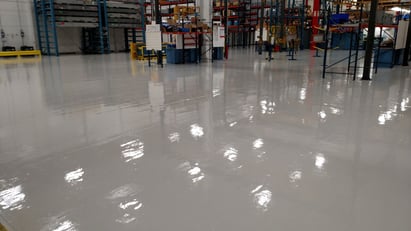 If you own an industrial facility, commercial space, or community building that needs a new floor coating, you’re probably wondering where to even start. With so many options out there today, it can be difficult to decide which is best for your facility.
If you own an industrial facility, commercial space, or community building that needs a new floor coating, you’re probably wondering where to even start. With so many options out there today, it can be difficult to decide which is best for your facility.
If you’ve decided against options such as concrete polishing and have settled on a coating, the next question is what kind of industrial floor coating to go for.
Two of the most common choices are urethane and epoxy. They can look rather similar to the untrained eye (in this photo, urethane is on the left and epoxy is on the right), but they have different properties.
Below we’ve weighed the benefits and drawbacks of each:
Epoxy Coatings: The Pros
.jpg?width=409&name=Epoxy%202%20(crop).jpg) An epoxy floor coating is a two-part system that results in an extremely hard and durable surface. If your workspace needs to support heavy traffic, an epoxy coating is shock resistant and helps to protect your facility’s floors both from the long-term impacts of heavy floor traffic as well as driving or even dropping heavy loads.
An epoxy floor coating is a two-part system that results in an extremely hard and durable surface. If your workspace needs to support heavy traffic, an epoxy coating is shock resistant and helps to protect your facility’s floors both from the long-term impacts of heavy floor traffic as well as driving or even dropping heavy loads.
Epoxy is available in a wide variety of colors, making it a good choice for 5S floor striping applications as well as creating attention-grabbing patterns or designs.
Additionally, epoxy is amazingly resistant to both water and chemical exposure. If your establishment uses a significant amount of liquids in day-to-day activities, this floor coating stops moisture from leaking into the floor itself, making cleanup easier and protecting the concrete beneath from damage.
Learn more about epoxy floor coatings.
Urethane Coatings: The Pros
 Abrasion resistant and more color-retentive than epoxy coatings, urethane floor coatings can last longer and look better. This type of flooring is designed to protect against ultra violet light and abrasions. If you have an industrial facility that gets a lot of daily use, this floor coating would be a good choice for you.
Abrasion resistant and more color-retentive than epoxy coatings, urethane floor coatings can last longer and look better. This type of flooring is designed to protect against ultra violet light and abrasions. If you have an industrial facility that gets a lot of daily use, this floor coating would be a good choice for you.
Urethane is also available in a wide array of colors, but can also be applied clear so that existing colors and textures of the floor can show through.
The surface preparation for urethane floor coatings is not usually as intense of a process, either. Like epoxy, urethane can adhere to previous finishes, so existing coatings do not always have to be removed prior to installation.
Learn more about the benefits of urethane flooring.
Epoxy Coatings: the Cons
Unfortuntely, time for installation may be epoxy's biggest downside. The most important step in installing an epoxy floor coating is the surface preparation. The surface of the concrete has to be thoroughly prepared before the coating can be installed, with all traces of oil residues (and possibly previous coatings) removed. This is because the epoxy cannot adhere properly to marginally prepared surfaces, resulting in potential floor coating failure.
Additionally, while an epoxy coating is strong, it is not permanent. Though the floor can withstand heavy impacts, cracking or chipping can occur if an object is too heavy or dropped at certain angles.
Urethane Coatings: The Cons
While the surface preparation process for urethane coatings, in some instances, may not have to be as extensive as for epoxy, the process of installation can still take some time. However, what you are left with is a durable, practically indestructible, long-lasting industrial facility floor.
Which is right for you?
Epoxy and urethane are sometime used in tandem, with a urethane coat applied over the epoxy, for the best of both worlds.
Not sure which to choose for your facility? One of our flooring experts would be glad to help you determine the best solution for your needs. Contact us online or call us at (864) 855-0600 for a free consultation.

